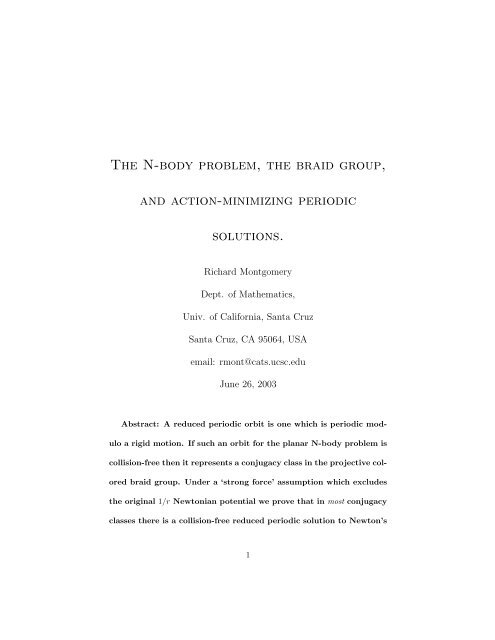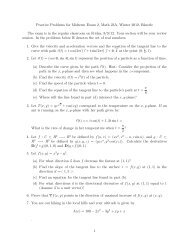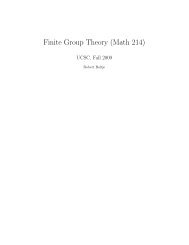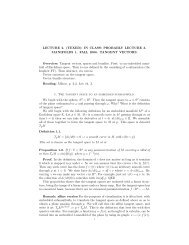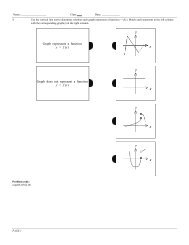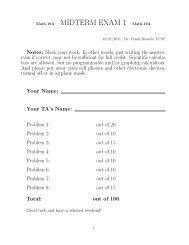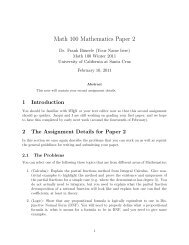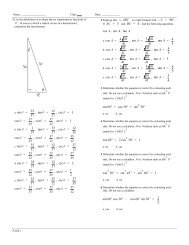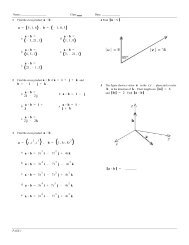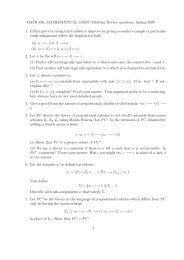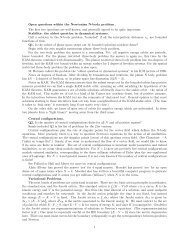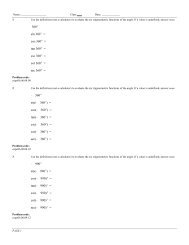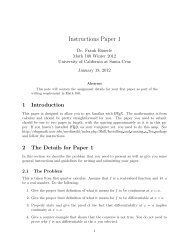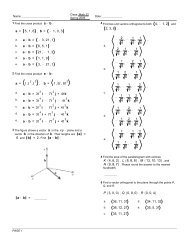The N-body problem, the braid group, and action-minimizing ...
The N-body problem, the braid group, and action-minimizing ...
The N-body problem, the braid group, and action-minimizing ...
Create successful ePaper yourself
Turn your PDF publications into a flip-book with our unique Google optimized e-Paper software.
<strong>The</strong> N-<strong>body</strong> <strong>problem</strong>, <strong>the</strong> <strong>braid</strong> <strong>group</strong>,<br />
<strong>and</strong> <strong>action</strong>-<strong>minimizing</strong> periodic<br />
solutions.<br />
Richard Montgomery<br />
Dept. of Ma<strong>the</strong>matics,<br />
Univ. of California, Santa Cruz<br />
Santa Cruz, CA 95064, USA<br />
email: rmont@cats.ucsc.edu<br />
June 26, 2003<br />
Abstract: A reduced periodic orbit is one which is periodic modulo<br />
a rigid motion. If such an orbit for <strong>the</strong> planar N-<strong>body</strong> <strong>problem</strong> is<br />
collision-free <strong>the</strong>n it represents a conjugacy class in <strong>the</strong> projective colored<br />
<strong>braid</strong> <strong>group</strong>. Under a ‘strong force’ assumption which excludes<br />
<strong>the</strong> original 1/r Newtonian potential we prove that in most conjugacy<br />
classes <strong>the</strong>re is a collision-free reduced periodic solution to Newton’s<br />
1
N-<strong>body</strong> equations. <strong>The</strong>se are <strong>the</strong> classes that are “tied” in <strong>the</strong> sense<br />
of Gordon [?]. We give explicit homological conditions which insure<br />
that a class tied. <strong>The</strong> method of proof is <strong>the</strong> direct method of <strong>the</strong><br />
calculus of variations. For <strong>the</strong> three-<strong>body</strong> <strong>problem</strong> we obtain qualitative<br />
information regarding <strong>the</strong> shape of our solutions which leads<br />
to a partial symbolic dynamics.<br />
1 Introduction <strong>and</strong> Results.<br />
Poincare emphasized <strong>the</strong> importance of periodic orbits in his famous work (<br />
[?], esp. §36 <strong>and</strong> §39-48 <strong>and</strong> p. I 42 of Goroff’s introduction). <strong>The</strong> orbits he<br />
investigates <strong>the</strong>re are not periodic in <strong>the</strong> st<strong>and</strong>ard sense. Ra<strong>the</strong>r, <strong>the</strong> mutual<br />
distances between bodies are periodic functions of time, but <strong>the</strong> placement <strong>and</strong><br />
orientation of <strong>the</strong> triangle formed by <strong>the</strong> bodies is allowed to change in one<br />
period. In center of mass coordinates this means that <strong>the</strong> entire system may<br />
suffer a rigid rotation after one period.<br />
We will call such orbits ’reduced periodic’. To be precise, a curve or motion<br />
γ(t) will be called “reduced periodic” with period T if <strong>the</strong>re is a rigid motion<br />
R such that γ(t + T ) = Rγ(t).<br />
<strong>The</strong> geometric arena for studying reduced<br />
periodic solutions to <strong>the</strong> planar N-<strong>body</strong> <strong>problem</strong> is <strong>the</strong> space C of proper<br />
congruence classes of planar N-gons.<br />
This is <strong>the</strong> quotient space Q/G of <strong>the</strong><br />
usual configuration space Q for <strong>the</strong> <strong>problem</strong>, by <strong>the</strong> <strong>group</strong> G of rigid motions<br />
2
of <strong>the</strong> plane. ( Q = IR 2 × IR 2 × ...× IR 2 is <strong>the</strong> N-fold product of <strong>the</strong> plane.)<br />
A curve in Q is reduced periodic if <strong>and</strong> only if its projection to C is periodic in<br />
<strong>the</strong> usual sense. We call C <strong>the</strong> “shape space” since its points represent shapes<br />
(congruence classes) of N-gons.<br />
<strong>The</strong> st<strong>and</strong>ard kinetic energy induces a very simple Riemannian metric on C.<br />
Namely, C = C(CIP N−2 )is<strong>the</strong>cone over complex projective N −2-space with<br />
its st<strong>and</strong>ard unitary-invariant (Fubini-Study) metric. <strong>The</strong> complex projective<br />
space represents similarity classes of oriented N-gons. For this reason we will<br />
sometimes refer to it as S, sothat S = CIP N−2 .(We recall <strong>the</strong> construction of<br />
<strong>the</strong> cone over S momentarily.) <strong>The</strong> remarkable simplicity of this metric space<br />
is central to our investigations. It was known to Iwai [?], <strong>and</strong> almost certainly<br />
before Iwai.<br />
In general, <strong>the</strong> cone C(X) over aRiemannian manifold X with metric ds 2<br />
is a metric space of one higher dimension constructed as follows. Topologically,<br />
C(X) =(X ×[0, ∞))/ ∼, where <strong>the</strong> “∼” means that all points of <strong>the</strong> form (x, 0)<br />
are “squashed”, or identified to a single point called <strong>the</strong> cone point, <strong>and</strong> denoted<br />
0. <strong>The</strong> metric on C(X) isdr 2 + r 2 ds 2 where r parameterizes <strong>the</strong> [0, ∞) factor,<br />
<strong>and</strong> equals <strong>the</strong> distance from 0. This metric is smooth everywhere except at 0.<br />
<strong>The</strong> homeomorphisms of C(X) induced by (x, r) ↦→ (x, λr), λ>0 are called<br />
<strong>the</strong> dilations. <strong>The</strong> dilation by λ multiplies <strong>the</strong> length of any curve by λ. In<br />
<strong>the</strong> N-<strong>body</strong> case this dilation corresponds to <strong>the</strong> st<strong>and</strong>ard Euclidean dilations<br />
of polygons.<br />
3
examples: <strong>The</strong> cone over a sphere of radius 1 is a Euclidean space. <strong>The</strong><br />
cone over a circle of radius less than 1 is one of <strong>the</strong> st<strong>and</strong>ard cones constructed<br />
by rolling up a piece of paper.<br />
<strong>The</strong> case of N =3of <strong>the</strong> three-<strong>body</strong> <strong>problem</strong> is especially simple. <strong>The</strong>n<br />
S = CIP 1 = S 2 ( 1 2 )is<strong>the</strong> two-sphere of radius 1 2<br />
. C(S) ishomeomorphic to<br />
IR 3 , but <strong>the</strong> metric on it is singular at <strong>the</strong> origin, which represents <strong>the</strong> cone<br />
point. This case was known to Lemaitre [?], [?], <strong>and</strong> Deprit-Delie [?], [?]. It is<br />
implicit in <strong>the</strong> qualitative picture of Moeckel [?] for three-<strong>body</strong> dynamics, <strong>and</strong><br />
in a paper of Saari [?]. It is also <strong>the</strong> central ingredient in an number of recent<br />
papers of Hsiang [?], [?], <strong>and</strong> in <strong>the</strong> author’s paper [?] inthis journal.<br />
We will be searching for collision-free orbits.<br />
<strong>The</strong> binary collisions, in<br />
which two of <strong>the</strong> N bodies co-incide, define distinguished subvarieties of codimension<br />
2 in C. <strong>The</strong>re are ( N<br />
2<br />
)<br />
such subvarieties, labelled Σij for <strong>the</strong> masses<br />
i, j which collide. We will denote <strong>the</strong>ir union by Σ. It consists of all possible<br />
collision configurations. A collision free reduced periodic curve is <strong>the</strong>n a closed<br />
curve in<br />
C ∗ = C \ Σ.<br />
GOAL : Given a free homotopy class in C ∗ , find a reduced periodic collisionfree<br />
solution to Newton’s equations for <strong>the</strong> motion of N bodies which realizes this<br />
solution.<br />
<strong>The</strong> set of free homotopy classes of any path-connected space X is in one-toone<br />
correspondence with <strong>the</strong> set of conjugacy classes of its fundamental <strong>group</strong>,<br />
4
π 1 (X). It is fairly well-known that <strong>the</strong> fundamental <strong>group</strong> of C ∗ is <strong>the</strong> projective<br />
colored <strong>braid</strong> <strong>group</strong>, by which we mean <strong>the</strong> quotient of <strong>the</strong> colored <strong>braid</strong><br />
<strong>group</strong> by its center. (<strong>The</strong> colored <strong>braid</strong> <strong>group</strong> on N str<strong>and</strong>s is <strong>the</strong> fundamental<br />
<strong>group</strong> of <strong>the</strong> N-<strong>body</strong> configuration space Q minus collisions. It is <strong>the</strong> normal<br />
sub<strong>group</strong> of <strong>the</strong> usual <strong>braid</strong> <strong>group</strong> which corresponds to each <strong>braid</strong> returning<br />
to its starting point. See Birman [?] for a detailed description of <strong>braid</strong> <strong>group</strong>s.)<br />
Hence, our goal is to find a reduced periodic solution realizing any<br />
given conjugacy class in <strong>the</strong> projective colored <strong>braid</strong> <strong>group</strong>.<br />
<strong>The</strong> situation is again particularly simple when N =3. <strong>The</strong> collision set<br />
Σ corresponds to three rays through <strong>the</strong> origin in IR 3 . So C ∗ is homotopic to<br />
<strong>the</strong> two-sphere minus three points. <strong>The</strong> resulting fundamental <strong>group</strong> is <strong>the</strong> free<br />
<strong>group</strong> on two letters.<br />
Our method of attack is <strong>the</strong> direct method of <strong>the</strong> calculus of variations,<br />
applied to curves on C. We will assume throughout that <strong>the</strong> potential energy<br />
V : Q → IR of <strong>the</strong> N-<strong>body</strong> <strong>problem</strong> is invariant under rigid motions. In this<br />
case it defines a function on C, which we will denote by <strong>the</strong> same symbol V .<br />
Any curve γ(t) ∈ Q defines a curve c(t) ∈ C of shapes. If γ satisfies Newton’s<br />
equations, <strong>the</strong>n c satisfies a second-order differential equation on C, which we<br />
call <strong>the</strong> reduced Newton’s equations.<br />
<strong>The</strong>se equations are parameterized by<br />
<strong>the</strong> (constant) value of <strong>the</strong> curve’s angular momentum J. <strong>The</strong> equations are<br />
markedly simpler when J =0,for in this case <strong>the</strong>y are Newton’s equations<br />
on C: ∇ċċ = −∇V where ∇ is <strong>the</strong> Levi-Civita connection on C.<br />
See, for<br />
5
example, Reinsch-Littlejohn [?] orMarsden-Ratiu [?].<br />
<strong>The</strong>se are <strong>the</strong> Euler-<br />
Lagrange equations on C for <strong>the</strong> functional<br />
∫<br />
c → A(c) = [ 1 2 ‖ċ(t)‖2 − V (c(t))]dt.<br />
of paths on<br />
C. We will call this <strong>the</strong> “reduced <strong>action</strong> functional”. (If J ≠0<br />
<strong>the</strong>n one must add an effective potential term, <strong>and</strong> a magnetic force to <strong>the</strong>se<br />
equations.<br />
<strong>The</strong> strength of <strong>the</strong> magnetic force is proportional to J <strong>and</strong> <strong>the</strong><br />
corresponding magnetic two-form is not exact. It follows that when J ≠0<strong>the</strong>re<br />
is no well-defined global <strong>action</strong> functional on C.)<br />
refined goal: Given a free homotopy class in C ∗ , find a reduced, periodic,<br />
zero-angular momentum, collision-free solution in this homotopy class which<br />
minimizes <strong>the</strong> reduced <strong>action</strong> among all loops in C ∗ in this class.<br />
<strong>The</strong>orem 1 below asserts that we can achieve this goal, provided we restrict<br />
<strong>the</strong> homotopy classes to a large (essentially dense) subset of <strong>the</strong> set of all classes,<br />
<strong>and</strong> provided we restrict <strong>the</strong> potential to be a “strong-force” potential. <strong>The</strong>orem<br />
1, combined with <strong>The</strong>orem 2 which provides a precise description of <strong>the</strong><br />
allowable classes, forms our main results.<br />
<strong>The</strong>se two restrictions are imposed in <strong>The</strong>orem 1 order to contend with <strong>the</strong><br />
two difficulties which arise in applying <strong>the</strong> direct method of <strong>the</strong> calculus of<br />
variations. <strong>The</strong>se difficulties correspond to <strong>the</strong> two types of non-compactness of<br />
C ∗ . <strong>The</strong> first non-compactness, or “infinity” (or end) is <strong>the</strong> usual spatial infinity.<br />
This infinity is approached by a curve c(t) inC whenever <strong>the</strong>re is some pair ij<br />
of masses whose Euclidean distance r ij (t) tends to infinity. <strong>The</strong> o<strong>the</strong>r type of<br />
6
“infinity” in C ∗ is <strong>the</strong> collision locus. It is approached whenever r ij (t) → 0 for<br />
some pair ij. Weovercome <strong>the</strong> first difficulty by making an assumption on <strong>the</strong><br />
free homotopy class of c. This assumption corresponds precisely to Gordon’s<br />
([?]) notion of being “tied” to a singularity. We overcome <strong>the</strong> second difficulty<br />
by a kind of a cheat, also found in Gordon, <strong>and</strong> very popular ever since, which<br />
is <strong>the</strong> “strong-force” assumption on <strong>the</strong> potential V .Wewill describe <strong>the</strong>se two<br />
assumptions in more detail momentarily.<br />
Comparisons with <strong>the</strong> Literature: Two of <strong>the</strong> central ideas of our paper,<br />
that of being “tied”, <strong>and</strong> <strong>the</strong> strong-force assumption, are due to Gordon.<br />
So in a sense our work is an appendix to Gordon.<br />
In this regard, our main<br />
contribution is <strong>The</strong>orem 2 which gives explicit <strong>braid</strong>-<strong>the</strong>oretic criteria which insure<br />
that a free homotopy class in C ∗ is “tied” in Gordon’s sense. Our criteria<br />
is purely homological, meaning that it is a condition of <strong>the</strong> image of <strong>the</strong> free<br />
homotopy class in <strong>the</strong> first homology <strong>group</strong> H 1 (C ∗ ). We make a second addition<br />
to Gordon’s work which is specific to <strong>the</strong> three-<strong>body</strong> <strong>problem</strong>. It occupies<br />
§4. <strong>The</strong>re we re-interpret our <strong>The</strong>orem 1 in terms of syzygies (eclipses), thus<br />
setting <strong>the</strong> stage for a possilbe symbolic dynamics for <strong>the</strong> three-<strong>body</strong> <strong>problem</strong>.<br />
Afinal contribution, is that we deal with reduced periodic orbits, whereas almost<br />
all of <strong>the</strong> existing variational literature on <strong>the</strong> N-<strong>body</strong> <strong>problem</strong>, (see for<br />
example [?], [?], [?] <strong>and</strong> references <strong>the</strong>rein) including Gordon’s, focuses on <strong>the</strong><br />
strictly periodic reduced. One exception is <strong>the</strong> interesting paper of Sbano [?]<br />
which investigates <strong>the</strong> relation between collisions <strong>and</strong> <strong>action</strong> minimization for<br />
7
<strong>the</strong> Newtonian 1/r potential.<br />
Tied classes: We now describe Gordon’s notions of “tied”. Let Y be a<br />
non-compact complete Riemannian metric space <strong>and</strong> Σ ⊂ Y a non-compact<br />
subvariety which we wish to avoid. Let α be a free homotopy class of loops in<br />
Y ∗ = Y \ Σ. Let us say that a sequence of loops c n ⊂ X tends to infinity if we<br />
can choose points P n ∈ c n such that <strong>the</strong> P n →∞. (When we say “P n →∞”<br />
we mean, that if we fix any base point 0 ∈ Y <strong>the</strong>n d(0,P n ) →∞.)<br />
Definition 1 We say that “α is tied to Σ” ifwhenever c n ∈ α is a sequence of<br />
representative loops tending to infinity, <strong>the</strong>n <strong>the</strong> lengths, l(c n ), tend to ∞.<br />
example: In <strong>the</strong> planar three-<strong>body</strong> <strong>problem</strong> Y = C(S), with S = S 2 ( 1 2 ). Σ<br />
is <strong>the</strong> union of three rays through <strong>the</strong> cone point 0. Any loop which encircles just<br />
one of <strong>the</strong> rays can be pushed out to infinity along that axis without changing<br />
its length. Hence <strong>the</strong> class represented by such a loop is NOT tied to Σ. On<br />
<strong>the</strong> o<strong>the</strong>r h<strong>and</strong>, <strong>the</strong> class of a “figure 8”, a loop which winds around two of<br />
<strong>the</strong> three rays, one clockwise <strong>and</strong> <strong>the</strong> o<strong>the</strong>r counterclockwise, forms a tied class.<br />
For its length is always greater than 2Rsin(φ) where R is its maximum distance<br />
from <strong>the</strong> cone point, <strong>and</strong> φ is <strong>the</strong> angular distance on S between <strong>the</strong> two points<br />
which represent <strong>the</strong> two rays. Note that 0
example of Gordon’s article. However, Gordon mistakenly asserted that it is<br />
not related to any physical <strong>problem</strong>.<br />
This concept of being tied is useful in studying natural mechanical systems<br />
on Y .<br />
We suppose that <strong>the</strong> kinetic energy is <strong>the</strong> one defined by <strong>the</strong> metric<br />
on Y , <strong>and</strong> that <strong>the</strong> potential energy is a nonpositive function V which has<br />
singularities on Σ: V (y n ) →−∞as y n → Σ. Newton’s equations on Y are<br />
∇ẏẏ = −∇V . <strong>The</strong> <strong>action</strong> functional for studying Newton’s equation on Y is<br />
A(y(·)) = ∫ 1<br />
2 ‖ẏ‖2 − V (y)dt as usual. We fix a tied class, <strong>and</strong> try to minimize<br />
A over all loops c :[0,T] → Y ∗ , c(0) = c(T ), which represent this class. We<br />
claim that any <strong>minimizing</strong> sequence c n ∈ α cannot tend to ∞. For if it did,<br />
<strong>the</strong>n its length l n = l(c n )would go to infinity by <strong>the</strong> definition of “tied”. And<br />
by Cauchy-Schwartz ( ∫ ‖ẏ‖ 2 )T ≥ l 2 n. Since −V ≥ 0itfollows that A(c n ) →∞,<br />
contradicting <strong>the</strong> assumption that c n was a<strong>minimizing</strong> sequence.<br />
strong forces: We now describe <strong>the</strong> “strong force” assumption on V ,<br />
introduced by Gordon to exclude collisions.<br />
Definition 2 Apotential V : Y → (−∞, 0] satisfies <strong>the</strong> strong force law if<br />
<strong>the</strong>re is some positive constant c such that V (y) < −c/ρ 2 whenever ρ = d(y, Σ)<br />
is sufficiently small, i.e. whenever <strong>the</strong> configuration y is sufficiently close to<br />
collision.<br />
examples: St<strong>and</strong>ard N <strong>body</strong> potentials are <strong>the</strong> sum of two <strong>body</strong> potential<br />
V ij : V =ΣV ij (r ij ) where r ij is <strong>the</strong> Euclidean distance between <strong>the</strong> ith <strong>and</strong> jth<br />
<strong>body</strong>, <strong>and</strong> <strong>the</strong> sum is over all distinct pairs ij. In this case <strong>the</strong> strong force<br />
9
law is equivalent to V ij (r) < −c/r 2 for r small enough.<br />
This is because on<br />
<strong>the</strong> shape space C, wehave d(y, Σ ij )=k ij r ij for some positive constant k ij<br />
depending only on <strong>the</strong> particle masses. <strong>The</strong> Maneff potential [?] isperhaps <strong>the</strong><br />
most popular of <strong>the</strong> strong force potentials. (See also Diacu [?] <strong>and</strong> references<br />
<strong>the</strong>rein.) <strong>The</strong> st<strong>and</strong>ard Newtonian potential is not a strong force law!<br />
Finite <strong>action</strong> curves in a strong force law must avoid collision. <strong>The</strong> argument<br />
is simple.<br />
Let γ[a, b] beanarc of a curve in Y with γ(b) ∈ Σ, <strong>and</strong> γ lying<br />
within <strong>the</strong> range in which <strong>the</strong> strong force assumption holds. <strong>The</strong>n A(γ) =<br />
1<br />
2 [∫ γ ds2 + ∫ 2c<br />
γ ρ<br />
dt]. But ds ≥ dρ <strong>and</strong> so ds 2 + 2c<br />
2 ρ<br />
≥ 2 √ 2cdρ/ρ. <strong>The</strong> integral of<br />
2<br />
<strong>the</strong> latter quantity diverges logarithmically as ρ → 0sothat A(γ) =+∞.<br />
Remark: Gordon’s original strong force assumption is that −V ≥|∇U| 2<br />
holds in some neighbhorhood of Σ, <strong>and</strong> for some function U which tends to ∞<br />
at Σ. Variants of this assumption are rampant in <strong>the</strong> recent literature on <strong>the</strong><br />
calculus of variations applied to <strong>the</strong> N <strong>body</strong> <strong>problem</strong>. <strong>The</strong>se typically are found<br />
as <strong>the</strong> last item in a list of half-a-dozen or so assumptions on <strong>the</strong> potential.<br />
Although <strong>the</strong>se assumptions are more general, we find <strong>the</strong>m to be more opaque,<br />
with no natural examples to justify this greater generality.<br />
We can now state our first <strong>the</strong>orem<br />
<strong>The</strong>orem 1 Suppose that <strong>the</strong> N-<strong>body</strong> potential satisfies <strong>the</strong> strong force condition:<br />
−V ≥ c/r 2 whenever <strong>the</strong> distance r between any two of <strong>the</strong> masses is<br />
sufficiently close. Suppose that <strong>the</strong> free homotopy class α on C ∗ is tied to <strong>the</strong><br />
collision locus. <strong>The</strong>n for any positive period T <strong>the</strong>re is a reduced periodic colli-<br />
10
sion free solution to <strong>the</strong> N-<strong>body</strong> <strong>problem</strong> which represents <strong>the</strong> homotopy class α,<br />
<strong>and</strong> which has period T . Itisobtained by <strong>minimizing</strong> <strong>the</strong> reduced <strong>action</strong> over<br />
<strong>the</strong> class α.<br />
Given what we have said regarding our two assumptions, <strong>the</strong> proof is a<br />
st<strong>and</strong>ard exercise in <strong>the</strong> calculus of variations.<br />
It is really embedded within<br />
Gordon’s paper, but for completeness we sketch it here.<br />
sketch of proof: Let c n ∈ α be any sequence of loops c n :[0,T] → C ∗ ,<br />
c n (0) = c n (T ), such that A(c n ) tends to <strong>the</strong> infimum of A over α. This infimum<br />
is a non-negative number, since we have assumed that −V ≥ 0 <strong>and</strong> so <strong>the</strong><br />
<strong>action</strong> is always positive. Since <strong>the</strong> class α is tied, <strong>and</strong> <strong>the</strong> <strong>action</strong>s A(c) are<br />
bounded, <strong>the</strong> sequence c n must lie in some bounded subset r ≤ k of C. Closed<br />
bounded subsets of C are compact. By <strong>the</strong> Arzela-Ascoli <strong>the</strong>orem, <strong>the</strong> sequence<br />
has a C 0 -convergent subsequence: c n → c 0 . By <strong>the</strong> lower-semicontinuity of A<br />
, c 0 has no collisions, for o<strong>the</strong>rwise A(c n )would tend to ∞ according to <strong>the</strong><br />
strong force assumption. Since c n → c 0 in <strong>the</strong> C 0 topology, <strong>the</strong> curve c 0 also<br />
represents α. By st<strong>and</strong>ard arguments in <strong>the</strong> calculus of variations, c 0 satisfies<br />
<strong>the</strong> Euler-Lagrange equations away from Σ. Since it never touches Σ it satisfies<br />
<strong>the</strong> equations everywhere.<br />
11
2 Tied <strong>and</strong> Tangled Classes<br />
<strong>The</strong>orem 1 would have little content if we did not have some description of <strong>the</strong><br />
tied classes. In particular we will want to know that this set of classes is nonempty!<br />
Our second <strong>the</strong>orem gives a computable sufficient condition for a class<br />
in C ∗ to be tied. As a corollary we can show that “almost all” classes are tied.<br />
W recall that <strong>the</strong>re is a canonical map F : π 1 = π 1 (C ∗ ) → H 1 (C ∗ ), <strong>the</strong><br />
Hurewicz map, which identifies H 1 (C ∗ ) with <strong>the</strong> Abelianization π 1 /[π 1 ,π 1 ]of<br />
π 1 . Since F (gh) =F (hg), F maps each conjugacy class, or free homotopy class,<br />
α ⊂ π 1 (C ∗ )toasingle element, denoted [α] ofH 1 (C ∗ ).<br />
We will need an explicit description of H 1 (C ∗ ). This is achieved by using <strong>the</strong><br />
canonical fibration G → Q ∗ → C ∗ where Q ∗ = Q\{collisions} <strong>and</strong> Q =(IR 2 ) n .<br />
<strong>The</strong> fundamental <strong>group</strong> of Q ∗ is <strong>the</strong> colored <strong>braid</strong> <strong>group</strong>, CB N ,onN <strong>braid</strong>s.<br />
Its center Z is <strong>the</strong> infinite cyclic sub<strong>group</strong> generated by <strong>the</strong> single element<br />
σ which corresponds to rigidly rotating all N masses once around.<br />
(Again,<br />
see Birman, [?].) It follows from this <strong>and</strong> <strong>the</strong> homotopy exact sequence that<br />
π 1 (C ∗ )=CB N /Z.(We are indebted to A. Knutson for this observation.)<br />
<strong>The</strong> homology, H 1 (Q ∗ )ofCB N is very well-understood. (See Arnol’d [?].)<br />
It has a canonical basis which is generated by <strong>the</strong> “tight binary stars”. By <strong>the</strong><br />
ij binary we mean <strong>the</strong> loop in Q ∗ obtained by having mass i <strong>and</strong> mass j move<br />
around each o<strong>the</strong>r in a circle, while all o<strong>the</strong>r masses are fixed, <strong>and</strong> far away. <strong>The</strong><br />
corresponding homology classes, a ij , form a ZZ basis for H 1 (Q ∗ ). <strong>The</strong> image of<br />
<strong>the</strong> generator σ of <strong>the</strong> center Z under <strong>the</strong> Hurewicz map is <strong>the</strong> sum [σ] =Σa ij<br />
12
of all of <strong>the</strong>se basis elements. It follows from all this <strong>and</strong> elementary algebraic<br />
topology that H 1 (C ∗ )is<strong>the</strong> <strong>group</strong> generated by <strong>the</strong> a ij with <strong>the</strong> single relation<br />
Σa ij =0.<br />
A basis for H 1 (C ∗ )isformed by singling out any pair i 0 j 0 of masses, <strong>and</strong><br />
deleting it from <strong>the</strong> list of a ij . Now let α be afree homotopy class in C ∗ <strong>and</strong><br />
[α] ∈ H 1 (C ∗ ) its image in homology. Exp<strong>and</strong> [α] interms of <strong>the</strong> basis:<br />
[α] =Σ ij≠i0j 0<br />
c ij a ij , (1)<br />
thus obtaining a collection of integers, c ij . We associate to this expansion a<br />
graph Γ i0j 0<br />
on N vertices. <strong>The</strong> vertices are labelled by <strong>the</strong> integers 1,...,N<br />
which label <strong>the</strong> N masses. <strong>The</strong>re is an edge connecting i to j if <strong>and</strong> only if<br />
c ij ≠0.<br />
<strong>The</strong>orem 2 If each of <strong>the</strong> ( N<br />
2<br />
)<br />
graphs Γi0j 0<br />
associated to α is connected, <strong>the</strong>n<br />
α is a tied class in <strong>the</strong> sense of Gordon.<br />
<strong>The</strong>orem 2 is proved in <strong>the</strong> final section of <strong>the</strong> paper.<br />
Definition 3 <strong>The</strong> classes [α] which satisfy <strong>the</strong> hypo<strong>the</strong>sis of <strong>The</strong>orem 2 will be<br />
called homologically tangled. <strong>The</strong> complementary set of classes in H 1 (C ∗ )<br />
will be called homologically seperable.<br />
Lemma 1 (ubiquity of tangled classes) Suppose that, for some choice {a ij :<br />
ij ≠ i 0 j 0 } of canonical basis, no more than N − 3 of <strong>the</strong> ( N<br />
2<br />
)<br />
− 1 coefficients cij<br />
in <strong>the</strong> expansion (??) of[α] vanish, <strong>and</strong> that no more than N − 3 of <strong>the</strong>m are<br />
equal. <strong>The</strong>n [α] is a homologically tangled class.<br />
13
example 1: <strong>The</strong> class with coefficients {c ij } = {1, 2, 3,... ( N<br />
2<br />
)<br />
− 1} is intertwined.<br />
example 2: In <strong>the</strong> case of <strong>the</strong> three <strong>body</strong> <strong>problem</strong>, <strong>the</strong>re are three a ij s<br />
corresponding to <strong>the</strong> three points on <strong>the</strong> two-sphere. A class is tied if when it<br />
is exp<strong>and</strong>ed as [α] =c 12 a 12 + c 23 a 23 <strong>the</strong>n c 12 ≠0,c 23 ≠0,<strong>and</strong> c 12 ≠ c 23 . One<br />
can check that <strong>the</strong>se are necessary <strong>and</strong> sufficient conditions for a class to be<br />
tied. In o<strong>the</strong>r words, <strong>the</strong> untied classes for N =3are precisely those classes<br />
represented by <strong>the</strong> powers of any one of <strong>the</strong> three tight binaries a ij .<br />
density of <strong>the</strong> tangled classes: Fix a canonical basis. <strong>The</strong> number of<br />
classes for which all of <strong>the</strong> |c ij | are less than or equal to a number R grows like<br />
R M where M = ( N<br />
2<br />
)<br />
−1is<strong>the</strong> rank of H1 (C ∗ ). <strong>The</strong> number of <strong>the</strong>se same classes<br />
which do not satisfy <strong>the</strong> hypo<strong>the</strong>ses of <strong>the</strong> above lemma grows like R M−(N+3) .<br />
Consequently, <strong>the</strong> density of “tied” homology classes is 1.<br />
Here “density” is<br />
defined, as in number <strong>the</strong>ory, to be <strong>the</strong> asymptotic ratio of <strong>the</strong> number of tied<br />
classes with |c ij |
Set I ∆ = {λ ≠ λ 0 : c λ = c λ1 }, I 0 = {λ ≠ λ 0 : c λ =0}, <strong>and</strong> Ī0 = {λ ≠ λ 1 :¯c λ =<br />
0}. Byasimple combinatorial argument, if |I ∆ |≤|I 0 | <strong>the</strong>n |Ī0| ≤|I 0 |. Our<br />
assumption is that |I 0 |, |I ∆ |≤N − 3. It follows that in any basis at most N − 3<br />
of <strong>the</strong> coefficients c ij vanish.<br />
So any of <strong>the</strong> corresponding graphs Γ = Γ i1j 1<br />
are obtained from <strong>the</strong> complete<br />
graph on N vertices by deleting at most N − 2 edges. <strong>The</strong> extra 1 in N − 2=<br />
N − 3+1 occurs because Γ i1j 1<br />
has no edge i 1 j 1 . <strong>The</strong> lemma now follows<br />
immediately from <strong>the</strong> following elementary graph <strong>the</strong>ory lemma, whose proof<br />
we leave to <strong>the</strong> reader.<br />
Lemma 2 If a certain graph is obtained by removing k edges from <strong>the</strong> complete<br />
graph on N vertices, <strong>and</strong> if that graph is disconnected, <strong>the</strong> we must have removed<br />
k ≥ N − 1 edges.<br />
3 Minimizing over untied classes<br />
What happens when we try to minimize over an untied class α? Let us suppose<br />
that <strong>the</strong> potential is of <strong>the</strong> st<strong>and</strong>ard type, meaning that V =ΣV ij (r ij is a<br />
sum over two-<strong>body</strong> potentials V ij , with each V ij < 0, <strong>and</strong> satisfying V ij → 0as<br />
r ij → 0. <strong>The</strong> Newtonian potential V ij = −m i m j /r ij satisfies this requirement,<br />
as does any inverse power law, <strong>and</strong> <strong>the</strong> Maneff potential.<br />
Proposition 1 If <strong>the</strong> potential is of <strong>the</strong> above st<strong>and</strong>ard type, <strong>and</strong> if <strong>the</strong> class α<br />
is untied <strong>the</strong>n it is impossible to realize <strong>the</strong> infimum of <strong>the</strong> <strong>action</strong> over loops in<br />
15
this class.<br />
Proving this proposition requires a better underst<strong>and</strong>ing of precisely what<br />
<strong>the</strong> untied classes are.<br />
We begin by working on Q ∗ , where <strong>the</strong> elements of<br />
π 1 (Q ∗ ) correspond to pure <strong>braid</strong>s. We first think of a colored <strong>braid</strong> in terms<br />
of <strong>the</strong> usual model, where it is a tangle of N colored strings, each joining a<br />
colored bead of its color on a ‘bottom plane’ to a similarly colored bead lying<br />
directly above this bead on a ‘top’ plane. Try to grab a subset of k
such that some of <strong>the</strong> bodies always lie in one half, <strong>and</strong> <strong>the</strong> o<strong>the</strong>rs lie in ano<strong>the</strong>r<br />
half. After a homotopy, we may suppose that this moving curve is <strong>the</strong> fixed line<br />
l.<br />
Definition 4 Aloopq(t) =(q 1 (t),...,q N (t)) in Q ∗ can be geometrically<br />
separated into two str<strong>and</strong>s if we can find a fixed line l ⊂ IR 2<br />
<strong>and</strong> a<br />
partition of <strong>the</strong> <strong>the</strong> mass labels {1, 2, 3, ...N} into two nonempty subsets I,J,<br />
I ∪ J = {1, 2,...,N} such that <strong>the</strong> bodies q i (t),i ∈ I lie strictly on one side of<br />
<strong>the</strong> line, <strong>and</strong> <strong>the</strong> q j (t), j ∈ J lies strictly on <strong>the</strong> o<strong>the</strong>r side, for all time t. Afree<br />
homotopy class in Q ∗ is said to be geometrically seperated into two str<strong>and</strong>s if it<br />
has a representative curve which is geometrically seperated into two str<strong>and</strong>s. A<br />
free homotopy class in C ∗ is geometrically separated into two str<strong>and</strong>s if one of<br />
its lifts to Q ∗ is geometrically separated into two str<strong>and</strong>s.<br />
Lemma 3 <strong>The</strong> following properties are equivalent for a conjugacy class α in<br />
ei<strong>the</strong>r π 1 (C ∗ ) or π 1 (Q ∗ )<br />
• (1) α is represented by a fully tangled <strong>braid</strong><br />
• (2) α cannot be geometrically seperated<br />
• (3) α is tied to <strong>the</strong> collisions<br />
proof of <strong>the</strong> lemma: <strong>The</strong> equivalence between (1) <strong>and</strong> (2) follows from<br />
<strong>the</strong> preceding discussion. Details are left to <strong>the</strong> reader.<br />
We prove <strong>the</strong> equivalence between (2) <strong>and</strong> (3) for classes in Q ∗ .<br />
Let α<br />
be ageometrically seperable class. Let q(t) =(q 1 (t),...,q N (t)) be a loop in<br />
17
Q ∗ which represents α <strong>and</strong> which is seperated by <strong>the</strong> line l into two clusters<br />
{q i : i ∈ I} <strong>and</strong> {q j : j ∈ J}, asindefinition 4. Let n be <strong>the</strong> normal to <strong>the</strong><br />
line, with n pointing into <strong>the</strong> half plane containing <strong>the</strong> I masses. Translate all<br />
of <strong>the</strong> I masses s units in <strong>the</strong> n direction <strong>and</strong> all of <strong>the</strong> J masses s units in<br />
<strong>the</strong> −n direction. This defines a homotopy corresponding to pulling <strong>the</strong> two<br />
<strong>group</strong>s of strings apart from each o<strong>the</strong>r. It does not change <strong>the</strong> length of <strong>the</strong><br />
path q(t)) but it has <strong>the</strong> property that r ij →∞as s →∞, whenever i ∈ I <strong>and</strong><br />
j ∈ J. Thus <strong>the</strong> class we started with is untied in Gordon’s sense. <strong>The</strong> reverse<br />
implication can be proved by reversing our arguments.<br />
Finally, <strong>the</strong> argument on C ∗ follows directly from <strong>the</strong> fact that π 1 (C ∗ )is<strong>the</strong><br />
colored <strong>braid</strong> <strong>group</strong> modulo its center, that <strong>the</strong> center is generated by rotations,<br />
<strong>and</strong> that rotations are unseen, <strong>and</strong> hence do not affect length, on C ∗ . Details<br />
are left to <strong>the</strong> reader.<br />
QED<br />
proof of proposition 1: Given an untied class α, wefollow <strong>the</strong> above<br />
‘untangling’ procedure. That is, we seperate <strong>the</strong> bodies into two subsets I <strong>and</strong><br />
J <strong>and</strong> translate <strong>the</strong>m out to infinity. Let A I denote <strong>the</strong> <strong>action</strong><br />
A I (q) =∫ 1<br />
2 Σ a∈Im a ‖ ˙q a ‖ 2 − Σ i1,i 2∈IV i1i 2<br />
(r i1i 2<br />
)<br />
<strong>and</strong> similarly for A J . Since −V ij > 0wehaveA(q) >A I (q) +A J (q) for any<br />
path q(t) inQ. We will show that if <strong>the</strong> infimum were realized it would have<br />
to satisfy A(q) =A I (q)+A J (q) thus obtaining a contradiction.<br />
18
Since α is untangled, we can write a <strong>group</strong> element a which represents it as<br />
a = a I a J . <strong>The</strong>se two elements commute. Here a I is <strong>the</strong> sub-<strong>braid</strong> representing<br />
<strong>the</strong> tangling of <strong>the</strong> <strong>braid</strong>s of <strong>the</strong> subset I.<br />
It can be realized as a loop q I<br />
in Q I = IR i 2 1<br />
× ...× IR i 2 l<br />
\{collisions} where <strong>the</strong> subscripts i j parameterize<br />
I <strong>and</strong> also label <strong>the</strong> masses involved. Let A I∗ denote <strong>the</strong> infimum of A I (q I )<br />
over all loops representing <strong>the</strong> conjugacy class a I . Let ɛ>0beagiven small<br />
number. We may choose <strong>the</strong> loop q I so that A I (q I )=A I∗ + ɛ. Similarly, we<br />
can define A J∗ <strong>and</strong> find a loop q J .Now, after possibly translating q I rigidly by<br />
some amount we can put <strong>the</strong>se seperate loops toge<strong>the</strong>r into a single loop in Q ∗<br />
which represents α <strong>and</strong> which has <strong>the</strong> property that <strong>the</strong> masses q i (t),i ∈ I are<br />
separated from <strong>the</strong> masses q j (t), j ∈ J by afixed line, as in definition 2. We<br />
now follow <strong>the</strong> previous procedure of translating <strong>the</strong> I-cluster away from <strong>the</strong> J<br />
cluster, along <strong>the</strong> normal direction. <strong>The</strong> resulting homotopy leaves <strong>the</strong> <strong>action</strong><br />
unchanged, except for <strong>the</strong> cross terms , −V ij (r ij ),i ∈ I,j ∈ J. As we let <strong>the</strong><br />
two clusters tend to infinity <strong>the</strong>se cross terms drop out <strong>and</strong> <strong>the</strong> total <strong>action</strong><br />
converges to A I (q I )+A J (q J )=A I∗ + A J∗ +2ɛ. Since ɛ was arbitrary, we see<br />
that A ∗ = A I∗ + A J∗ , <strong>and</strong> consequently <strong>the</strong> infimum of A cannot be realized by<br />
any actual loop.<br />
<strong>The</strong> idea for <strong>the</strong> <strong>problem</strong> in C ∗ is essentially <strong>the</strong> same, but rotations have<br />
to be kept track of. QED<br />
example: Consider <strong>the</strong> case where α is represented by a single generator,<br />
say a 12 , for <strong>the</strong> three-<strong>body</strong> <strong>problem</strong>. Recall this corresponds to a tight binary.<br />
19
Gordon [?] has shown that any Kepler orbit realizes <strong>the</strong> infimum A 12∗ of <strong>the</strong><br />
<strong>action</strong> for <strong>the</strong> two-<strong>body</strong> <strong>problem</strong> over <strong>the</strong> single generator of <strong>the</strong> homotopy <strong>group</strong><br />
for that <strong>problem</strong>. (<strong>The</strong> configuration of <strong>the</strong> two-<strong>body</strong> <strong>problem</strong> minus collisions<br />
retracts onto <strong>the</strong> circle.) It follows that <strong>the</strong> infimum of A(γ) over <strong>the</strong> γ ∈ a 12<br />
tends to <strong>the</strong> Kepler <strong>action</strong> A 12∗ <strong>and</strong> is not realized by any actual loop. Ra<strong>the</strong>r<br />
it is approached by a sequence γ i of actual orbits in which masses 1 <strong>and</strong> 2 move<br />
in a Kepler orbit, <strong>and</strong> 3 stays fixed. <strong>The</strong> distance d i between <strong>the</strong> 12-center of<br />
mass system <strong>and</strong> 3 tends to infinity as i →∞.<br />
4 <strong>The</strong> Case of Three Bodies<br />
When N =3we can give a more detailed description of <strong>the</strong> qualitative nature<br />
of our minimizers.<br />
This is possible because of <strong>the</strong> greater simpicity of <strong>the</strong><br />
fundamental <strong>group</strong> <strong>and</strong> of <strong>the</strong> geometry of <strong>the</strong> shape space C ∗ in this case.<br />
<strong>The</strong> N =3shape space is <strong>the</strong> cone over <strong>the</strong> sphere S of radius 1/2. This<br />
points of this sphere represent similarity classes of oriented triangles. <strong>The</strong> equator<br />
E ⊂ S represents <strong>the</strong> set of similarity classes of collinear triangles. E has<br />
three marked points, <strong>the</strong> three binary collisions. <strong>The</strong>se divide E into three arcs.<br />
Apoint of E, orapoint of <strong>the</strong> plane C(E) ⊂ C = C(S) will be called a syzygy,<br />
eclipse, or collinear configuration.<br />
We can introduce st<strong>and</strong>ard spherical coordinates (r, θ, φ) onC such that <strong>the</strong><br />
metric is dr 2 + 1 4 r2 (dφ 2 + sin 2 φdθ 2 ). <strong>The</strong> cone point is defined by r =0<strong>and</strong><br />
20
epresents triple collision. <strong>The</strong> sphere S is identified with <strong>the</strong> locus {r =1}.<br />
C(E) isdefined by φ = π/2. <strong>The</strong> height coordinate h = rcos(φ) isproportional<br />
to <strong>the</strong> signed area of <strong>the</strong> corresponding triangle. (<strong>The</strong> proportionality constant<br />
depends only on <strong>the</strong> ratios three masses.) Any improper isometry of <strong>the</strong> plane,<br />
such as (x, y) ↦→ (x, −y), reverses <strong>the</strong> orientation of triangles <strong>and</strong> induces an<br />
isometric involution<br />
τ : C → C<br />
of C. Incoordinates τ((r, θ, h)) = (r, θ, −h). <strong>The</strong> fixed point set of this isometric<br />
involution is C(E). <strong>The</strong>refore C(E) isatotally geodesic submanifold. This<br />
involution τ also leaves any st<strong>and</strong>ard potential V =ΣV ij (r ij )invariant, since<br />
<strong>the</strong> r ij are invariant under <strong>the</strong> full <strong>group</strong> of isometries of <strong>the</strong> plane, including <strong>the</strong><br />
improper ones. Hence τ preserves <strong>the</strong> <strong>action</strong> of paths in C, <strong>and</strong> maps solutions<br />
of <strong>the</strong> reduced Newton’s equations to solutions.<br />
Any curve in C without triple collisions can be projected radially onto <strong>the</strong><br />
sphere S of similarity classes. We call this projected curve its “spherical image”.<br />
<strong>The</strong>orem 3 Suppose that a closed curve in C ∗ = C \ collisions realizes our<br />
refined goal, namely it minimizes <strong>the</strong> reduced <strong>action</strong> over all loops in C ∗ lying<br />
in its homotopy class <strong>and</strong> having its period. <strong>The</strong>n <strong>the</strong> spherical image of this<br />
curve intersects <strong>the</strong> equator a finite number of times. <strong>The</strong> consecutive points of<br />
intersection must lie on different arcs of <strong>the</strong> equator.<br />
sketch of proof : <strong>The</strong> curve must satisfy a differential equation, so cannot<br />
21
have an infinite number of intersection points with C(E) unless it lies on C(E).<br />
But this is impossible since it represents a nontrivial homotopy class.<br />
If <strong>the</strong> curve had an subarc whose endpoints lay on <strong>the</strong> same arc of E, <strong>the</strong>n<br />
we could obtain a new curve by applying <strong>the</strong> isometric involution τ to this arc,<br />
while leaving <strong>the</strong> rest of <strong>the</strong> curve <strong>the</strong> same. <strong>The</strong> result would be a closed curve<br />
in <strong>the</strong> same homotopy class, with <strong>the</strong> same <strong>action</strong>. But this new curve dips<br />
down to touch <strong>the</strong> plane C(E), <strong>and</strong> <strong>the</strong>n “bounces” back up without crossing<br />
C(E). This contradicts its minimality. (It also contradicts <strong>the</strong> fact that <strong>the</strong> new<br />
curve is also a minimizer <strong>and</strong> so must satisfy <strong>the</strong> reduced Newton’s equations.)<br />
QED<br />
We can re-interpret <strong>the</strong>orems 1 <strong>and</strong> 3 in terms of a symbolic dynamics in<br />
which each free homotopy class is encoded by its sequence of syzygies, or equatorial<br />
crossings. This encoding is essentially <strong>the</strong> same as that of Morse [?].<br />
Label <strong>the</strong> three arcs of <strong>the</strong> equator E between <strong>the</strong> three collision points with<br />
<strong>the</strong> letters A, B, <strong>and</strong> C. Recall that E divides <strong>the</strong> sphere into two hemispheres,<br />
according to whe<strong>the</strong>r <strong>the</strong> triangles are positively or negatively oriented with<br />
respect to a fixed orientation of <strong>the</strong> plane (i.e.<br />
according to <strong>the</strong> sign of h).<br />
Let A + st<strong>and</strong> for any oriented arc s(t) lying wholly in <strong>the</strong> upper hemisphere<br />
<strong>and</strong> approaching <strong>the</strong> ecliptic arc A ⊂ E. Said more carefully, A + st<strong>and</strong>s for<br />
any arc s(a, b] for which s(b) ∈ A <strong>and</strong> s(a, b) lies in <strong>the</strong> upper hemisphere.<br />
Similary, A − denotes an arc approaching A from below.<br />
We use analogous<br />
symbols B + ,B − ,C + ,C − for B <strong>and</strong> C <strong>and</strong> in this way obtain an alphabet with<br />
22
six symbols. We can use <strong>the</strong>se symbols to generate unique representatives of<br />
all <strong>the</strong> free homotopy classes. For example, A + B − represents <strong>the</strong> generator a 12<br />
encircling <strong>the</strong> 12 collision. And <strong>the</strong> word B + C − B + A − corresponds to a figure<br />
8.<br />
Now A + A − represents a contractible arc, <strong>and</strong> so does A + B + . <strong>The</strong>se suggest<br />
that we impose certain rules of grammar.<br />
Rule 1: We do not allow words for which two of <strong>the</strong> same letters XX appear<br />
in a row (whatever <strong>the</strong>ir ± subscripts).<br />
Rule 2: Whenever <strong>the</strong> pair X ɛ Y δ occurs in a word <strong>the</strong> subscripts ɛ, δ = ± have<br />
opposite parity: δ = −ɛ.<br />
Note that <strong>the</strong>orem 3 is a variational counterpart of <strong>the</strong>se rules.<br />
Since <strong>the</strong> words are meant to represent <strong>the</strong> free homotopy class of a loop,<br />
<strong>the</strong>y must have an even number of elements. And <strong>the</strong>y should be viewed as cyclic<br />
words, meaning that <strong>the</strong> same class is represented by any cyclic permutation of<br />
this word. For example:<br />
A + B − A + B − C + B − = B − A + B − A + B − C + .<br />
Both rules of grammar must hold for each cyclic permutation of <strong>the</strong> word. This<br />
23
is equivalent to insisting on<br />
Rule 3: <strong>The</strong> beginning <strong>and</strong> ending letters of <strong>the</strong> word are different.<br />
In this manner we can encode each free homotopy class as a cyclic word in<br />
our six letter alphabet, subject to <strong>the</strong> above rules of grammar. We leave it as<br />
an exercise to <strong>the</strong> reader to show that this representation is unique.<br />
Recall from above that <strong>the</strong> “untied” classes are simply those classes which<br />
are represented by a powers of a single generator. If we want to insure that<br />
aword does not represent a power of a generator, we merely need to add <strong>the</strong><br />
condition that all three letters A, B <strong>and</strong> C appear in our word. We can now<br />
restate <strong>the</strong>orem 1 <strong>and</strong> 3 as follows:<br />
Corollary 1 (Symbolic Dynamics) Let afinite word be given in our alphabet,<br />
subject to <strong>the</strong> above Rules 1 , 2 <strong>and</strong> 3 of grammar, <strong>and</strong> such that all three<br />
letters A, B <strong>and</strong> C occur in this word. Let a period of time be given. Suppose<br />
that <strong>the</strong> potential satisfies <strong>the</strong> strong force hypo<strong>the</strong>sis of <strong>The</strong>orem 1. <strong>The</strong>n <strong>the</strong>re<br />
is a reduced periodic three-<strong>body</strong> solution following <strong>the</strong> sequence of syzygies specified<br />
by this word. This solution has zero angular momentum <strong>and</strong> minimizes <strong>the</strong><br />
<strong>action</strong> among all collision-free reduced periodic loops following this sequence of<br />
syzygies in this time.<br />
24
5 Proof of <strong>the</strong>orem 2: tied <strong>and</strong> tangled classes<br />
<strong>The</strong> purpose of this section is to prove <strong>the</strong>orem 2, <strong>and</strong> to better underst<strong>and</strong> <strong>the</strong><br />
tied <strong>and</strong> <strong>the</strong> tangled classes.<br />
We begin with some general facts regarding tied classes on cones. Suppose<br />
C(X) is<strong>the</strong> cone over a compact Riemannian manifold X.<br />
Let Σ = C(D)<br />
play <strong>the</strong> role of <strong>the</strong> collision locus, where D ⊂ X is a closed subset. Radial<br />
dilation defines a retr<strong>action</strong> of C(X) ∗ := C(X) \ C(D) ontoX ∗ = X \ D. In<br />
particular, free homotopy classes in C(X) ∗ are in one-to-one correspondence<br />
with free homotopy classes in X ∗ .<br />
We will say that such a class in X ∗ is a<br />
vanishing class if it has a representative loop c for which <strong>the</strong>re is a homotopy<br />
c s ⊂ X ∗ ,0≤ s
Lemma 4 Afree homotopy class in C(X) ∗ is tied to Σ if <strong>and</strong> only if its corresponding<br />
class in X ∗ is not a vanishing class.<br />
proof: Suppose α is a vanishing class, represented by a “vanishing homotopy”,<br />
c R . Wemay suppose that 0 ≤ R
trigonometry. Within this cone, γ is a curve whose far<strong>the</strong>st point is a distance<br />
R from <strong>the</strong> origin, <strong>and</strong> which subtends an angle of measure φ = l(c), <strong>the</strong> length<br />
of c.<br />
By basic trigonometry, we have l(γ) ≥ 2Rsin(φ/2) if φ < π/2, <strong>and</strong><br />
l(γ) ≥ 2R o<strong>the</strong>rwise. Since l(c) ≥ δ we have <strong>the</strong> desired inequality <strong>and</strong> <strong>the</strong><br />
proof is complete. QED<br />
To approach <strong>the</strong> proof of <strong>The</strong>orem 2, we ask <strong>the</strong> reader to first take a moment<br />
to reflect on <strong>the</strong> definitions of “homologically tangled” <strong>and</strong> “homologically<br />
seperated” back in §2. To proceed, we will need a more geometric characterization<br />
of <strong>the</strong>se concepts. Let Q 0 ⊂ Q denote <strong>the</strong> subspace consisting of those<br />
configurations whose center of mass is at <strong>the</strong> origin. Thus q =(q 1 ,...,q N ) ∈ Q 0<br />
if <strong>and</strong> only if Σm a q a =0∈ IR 2 . Here <strong>the</strong> m a ,a =1,...,N are <strong>the</strong> masses of<br />
<strong>the</strong> bodies, <strong>and</strong> <strong>the</strong> q a ∈ IR 2 represent <strong>the</strong> positions of <strong>the</strong> bodies. It is clear<br />
that Q/G = Q 0 /SO(2), where SO(2) denotes <strong>the</strong> <strong>group</strong> of rotations about <strong>the</strong><br />
center of mass. And so C ∗ ∼ = Q ∗ 0/G where<br />
Q ∗ 0 = {q ∈ Q 0 : q i ≠ q j for all pairs i, j}.<br />
Set<br />
∆ ij = {q ∈ Q 0 : q i = q j }⊂Q 0 (2)<br />
so that Q ∗ 0 = Q 0 \ ∆ i j. (Note <strong>the</strong> varieties Σ ij which we delete from C to form<br />
C ∗ are ∆ ij /G.)<br />
Lemma 5 Let E denote <strong>the</strong> edge set of <strong>the</strong> graph Γ=Γ i0j 0<br />
(α). <strong>The</strong> graph is<br />
27
disconnected if <strong>and</strong> only if<br />
∩ ij∈E ∆ ij = {0} ⊂Q 0 . (3)<br />
proof of lemma:. Suppose <strong>the</strong> graph is connected. <strong>The</strong>n <strong>the</strong>re is a circuit<br />
of edges passing through all N vertices, <strong>and</strong> this circuit is a subset of <strong>the</strong> edges<br />
set E. Wewill show that <strong>the</strong> intersection of <strong>the</strong> ∆ ij over only <strong>the</strong> edges in this<br />
circuit is {0}. Forif a point q is in this intersection, <strong>the</strong>n q 1 = q 2 = ...q N . But<br />
Σm i q i =0<strong>and</strong> Σm i q i = Mq 1 where M =Σm i so that all <strong>the</strong> q i =0. <strong>The</strong> point<br />
q of intersection must be <strong>the</strong> N-tuple collision point 0.<br />
Conversely, if <strong>the</strong> graph is disconnected, <strong>the</strong>n <strong>the</strong> vertices fall into at least<br />
two components, so we can partition <strong>the</strong>m into two nonempty subsets I,J ⊂<br />
{1, 2,...,N}, I ∪ J = {1, 2,...,N} with no vertex in I connected to one in J<br />
by an edge. Set M I =Σ i∈I m i , M J =Σ j∈J m i . Pick r, s ∈ IR 2 ,r,s ≠0such<br />
that M I r + M J s =0<strong>The</strong>n <strong>the</strong> element q =(q 1 ,...,q N ) with q i = r, i ∈ I,<br />
q j = s, j ∈ J is a nonzero vector lying in <strong>the</strong> intersection.<br />
Lemma 6 If <strong>the</strong> free homotopy class α represents a vanishing class in S ∗ <strong>the</strong>n<br />
its image [α] in <strong>the</strong> first homology of C ∗ is homologically separable into two<br />
str<strong>and</strong>s.<br />
proof of <strong>the</strong>orem 2: <strong>The</strong>orem 2 is <strong>the</strong> contrapositive of <strong>the</strong> implication<br />
just asserted, according to lemma 4.<br />
Proof of <strong>the</strong> lemma:<br />
Let Σ ij ⊂ S = CIP N−2 denote <strong>the</strong> binary collision loci in S. <strong>The</strong>se can be<br />
28
obtained by taking <strong>the</strong> images of <strong>the</strong> collision loci ∆ ij ⊂ Q 0 ⊂ Q in C under<br />
<strong>the</strong> quotient map Q 0 → Q 0 /(SO(2) = C <strong>and</strong> <strong>the</strong>n intersecting <strong>the</strong>se images<br />
with S ⊂ C. <strong>The</strong>y are hyperplanes in <strong>the</strong> complex projective space S. Lemma<br />
5 translates to assert that <strong>the</strong> class α is homologically separated if <strong>and</strong> only if<br />
for some i 0 j 0 we have<br />
∩ ij∈E Σ ij ≠ ∅ (4)<br />
Suppose that α is a vanishing class, so that <strong>the</strong> infimum of <strong>the</strong> lengths of <strong>the</strong><br />
curves representing it is zero. <strong>The</strong>n <strong>the</strong>re is a sequence of loops γ n in S ∗ which<br />
represent <strong>the</strong> class α <strong>and</strong> whose diameters tend to zero. By compactness of S<br />
we can find a subsequence of paths which tend to a fixed point P ∈ S. Pcannot<br />
lie in all of <strong>the</strong> Σ ij since <strong>the</strong> intersection of all of <strong>the</strong>m is empty. Hence <strong>the</strong>re<br />
is at least one, say Σ i0j 0<br />
which it does not lie in. Consider <strong>the</strong> corresponding<br />
basis {a ij<br />
: ij ≠ i 0 j 0 } for H 1 (C ∗ ) <strong>and</strong> <strong>the</strong> associated graph Γ = Γ i0j 0<br />
(α),<br />
with its edge set E We will show that P ∈∩ ij∈E Σ ij . This will prove that <strong>the</strong><br />
intersection is non-empty <strong>and</strong> <strong>the</strong> class [α] ishomologically separated, according<br />
to <strong>the</strong> inequality (4).<br />
Let ω ij , ij ≠ i 0 j 0 ,be<strong>the</strong> basis for <strong>the</strong> 1st cohomology <strong>group</strong> which is dual<br />
to <strong>the</strong> basis we have just chosen for <strong>the</strong> 1st homology. <strong>The</strong> classes ω ij can be<br />
represented as differential one-forms, in which case <strong>the</strong> integers c ij are given by<br />
∫<br />
c ij = ω ij .<br />
γ n<br />
Let w 1 ,...,w N−2 be complex affine coordinates for S \ Σ i0j 0<br />
so that Σ ij is<br />
29
defined by <strong>the</strong> equation w 1 =0. <strong>The</strong>n ω ij = 1 dw 1<br />
2πi w 1<br />
. We will show that if<br />
c ij ≠0(for some {ij} ≠ {i 0 j 0 }) <strong>the</strong>n P ∈ Σ ij . Our proof is by contraposition.<br />
Suppose P /∈ Σ ij . Let B be asmall ball centered at P disjoint from Σ ij . With<br />
respect to <strong>the</strong> coordinates w i above we have, for n sufficiently large, γ n (t) =<br />
(w 1 (t),w 2 (t),...,w N−2 (t)) with w 1 (t) lying in a small disc disjoint from <strong>the</strong><br />
origin. Itfollows from <strong>the</strong> above representations for c ij <strong>and</strong> ω ij <strong>and</strong> <strong>the</strong> Cauchy<br />
integral formula that c ij =0.<br />
6 Acknowledgements<br />
Iwould like to thank Cesar Castilho, Chris Golé, Franchesco Fasso, <strong>and</strong> Alan<br />
Weinstein for useful conversations, <strong>and</strong> Allen Knutson for lessons on <strong>the</strong> projective<br />
<strong>braid</strong> <strong>group</strong>. I would especially like to thank Wu-Yi Hsiang for suggesting<br />
<strong>the</strong> bulk of <strong>the</strong> <strong>problem</strong>s here, <strong>and</strong> for inspiration. This work was supported<br />
by NSF grant DMS-9400515 <strong>and</strong> a University of Santa Cruz Faculty Research<br />
Grant. I would also like to thank Jean-Claude Hausmann <strong>and</strong> <strong>the</strong> University of<br />
Geneva for hospitality during <strong>the</strong> writing, <strong>and</strong> CIMAT in Guanajuato, Mexico,<br />
during <strong>the</strong> rewriting.<br />
30
7 Bibliography<br />
References<br />
[1] A. Ambrosetti, V. Zelati, Periodic Solutions of Singular Lagrangian<br />
Systems, Birkhäuser, Boston, 1993.<br />
[2] V.I. Arnol’d, <strong>The</strong> Cohomology of <strong>the</strong> Colored Braid Group, Math Zametki<br />
5, no. 2, 227-231; English translation: Math. Notes. 5, 138-140 (1969).<br />
[3] A. Bahri <strong>and</strong> P. Rabinowitz, Periodic solutions of Hamiltonian systems of<br />
3-<strong>body</strong> type , Annales Inst. Henri Poincaré, Analyse non linéaire, v. 8, no.<br />
6,561-649, (1991).<br />
[4] A. Deprit <strong>and</strong> A. Delie, Régularisation du problème des trois corps, Arch.<br />
for Rat. Mech., 12, 325-353, (1962).<br />
[5] A. Deprit, et A. Delie, Courbure de la métrique riemannienne du probème<br />
plan des trois corps, Bull. Cl. Sc. Acad. Belg. , no. 5, 48, 652-658, (1962).<br />
[6] J. Birman, Braids, Links <strong>and</strong> Mapping Class Groups, Princeton Univ.<br />
Press, Annals of Math Studies v. 88, (1975).<br />
[7] F. Diacu, <strong>The</strong> planar isosceles <strong>problem</strong> for Maneff’s gravitational law J.<br />
Math. Phys., v. 34, no. 12, 5671-5690, (1993).<br />
[8] W. Gordon, A Minimizing Property of Keplerian Orbits, Am. J. Math, 99,<br />
no. 5, 961-071, (1977).<br />
31
[9] W-Y Hsiang, Geometric Study of <strong>the</strong> Three-Body Problem I, report PAM-<br />
620, Center for Pure <strong>and</strong> Applied Math, University California, Berkeley,<br />
1994.<br />
[10] W-Y Hsiang <strong>and</strong> E. Straume, , Kinematic Geometric of triangles with given<br />
mass distribution,report PAM-636, Center for Pure <strong>and</strong> Applied Math, University<br />
California, Berkeley, 1995.<br />
[11] W-Y Hsiang, Kinematic Geometric of mass triangles <strong>and</strong> <strong>the</strong> three-<strong>body</strong><br />
<strong>problem</strong> in quantum mechanics, report PAM-682, Center for Pure <strong>and</strong> Applied<br />
Math, University California, Berkeley, 1996.<br />
[12] T. Iwai, Ageometric setting for classical molecular dynamics, Ann. Inst.<br />
Henri Poincare, vol. 47, no. 2, pp 199-219. (1987).<br />
[13] T. Iwai, Ageometric setting for internal motions of <strong>the</strong> quantum three-<strong>body</strong><br />
<strong>problem</strong>, J.Math. Phys., v. 28, 1315-1226, (1987).<br />
[14] G. Lemaitre, Coordonnées symétriques dans le problème des trois corps,<br />
Bull. Cl. Sc. Acad. Belg. no. 5, 38, 582-592, 1218-1234, (1952).<br />
[15] G. Lemaitre Regularization of <strong>the</strong> Three Body Problem, inVistas in Astronomy,<br />
1, 207-215, (1955).<br />
[16] T. Levi-Civita, Sur La Réqularisation du Problème des Trois Corps, Acta<br />
Math., v. 42, 99-144; esp. p. 105, eq.(12); (1921).<br />
32
[17] R.G. Littlejohn, RG <strong>and</strong> M. Reinsch, Gauge fields in <strong>the</strong> separation of<br />
rotations <strong>and</strong> internal motions in <strong>the</strong> n-<strong>body</strong> <strong>problem</strong>, Reviews of Modern<br />
Physics, 69 no. 1, 213-275, (1997).<br />
[18] P. Majer <strong>and</strong> S. Terracini, Periodic solutions to some <strong>problem</strong>s of n-<strong>body</strong><br />
type, Arch. Rat. Mech., 124, no. 4, 381-404, (1993).<br />
[19] G. Maneff, La gravitation et l’énergie au zéro, Comptes Rendus, v. 190,<br />
1374-1377, (1930).<br />
[20] J. Marsden <strong>and</strong> T. Ratiu, Introduction to Mechanics with Symmetry,<br />
Springer-Verlag,1994.<br />
[21] R. Moeckel, Some qualitative features of <strong>the</strong> three-<strong>body</strong> <strong>problem</strong> in Hamiltonian<br />
Dynamical Systems, proceedings, AMS Contemporary Math,<br />
81, ed. K. Meyer <strong>and</strong> C. Saari, 1-22, American Math. Society, (1988).<br />
[22] R. Montgomery, <strong>The</strong> geometric phase of <strong>the</strong> three-<strong>body</strong> <strong>problem</strong>, Nonlinearity,<br />
9, no. 5, 1341-1360, (1996).<br />
[23] M. Morse, AFundamental Class of Geodesics on Any Closed Surface of<br />
Genus Greater Than One, Trans. AMS, v. 26 (1924).P, History of Modern<br />
Physics <strong>and</strong> Astronomy v. 13, (1993).<br />
[24] H. Poincaré, Les Methodes Nouvelles de la Mécanique Céleste v. 1,<br />
ch. 3,Paris, Gauthier-Villars et fils, (1892).<br />
see also<br />
33
introduction to <strong>the</strong> English translation by D. Goroff, p. I 42. AIP, History<br />
of Modern Physics <strong>and</strong> Astronomy v. 13, (1993).<br />
[25] D. Saari, Symmetry in n-particle systems, inHamiltonian Dynamical<br />
Systems, proceedings, AMS Contemporary Math, Vol. 81, ed. K.<br />
Meyer <strong>and</strong> C. Saari, 23-42, esp. 26-27, American Math. Society, (1988).<br />
[26] L. Sbano, On <strong>the</strong> Lack of Coercivity of <strong>the</strong> reduced Action-functional for<br />
zero total angular momentum in <strong>the</strong> planar three <strong>body</strong> <strong>problem</strong>, SISSA/ISAS<br />
preprint 185/94/FM, (1994).<br />
34


